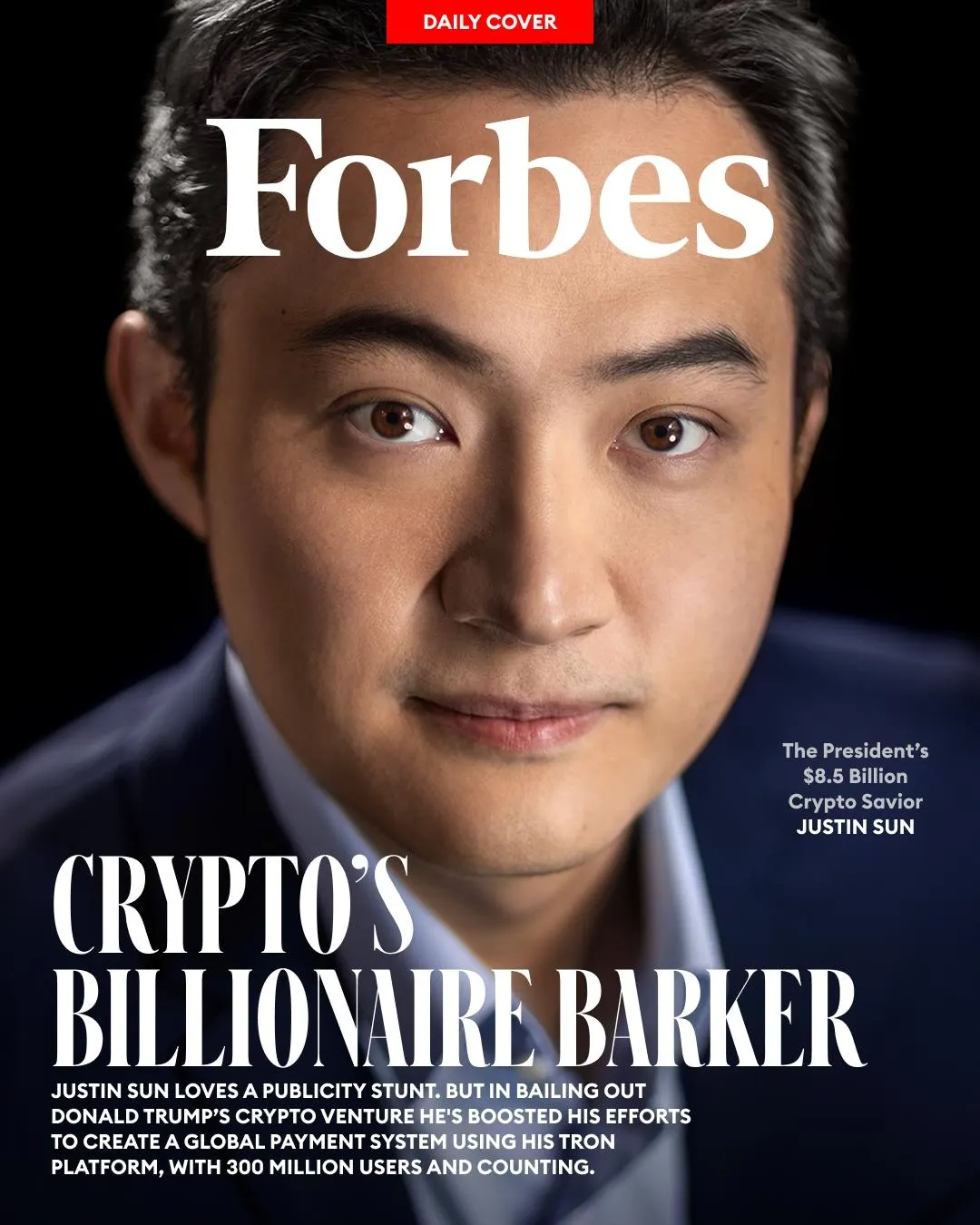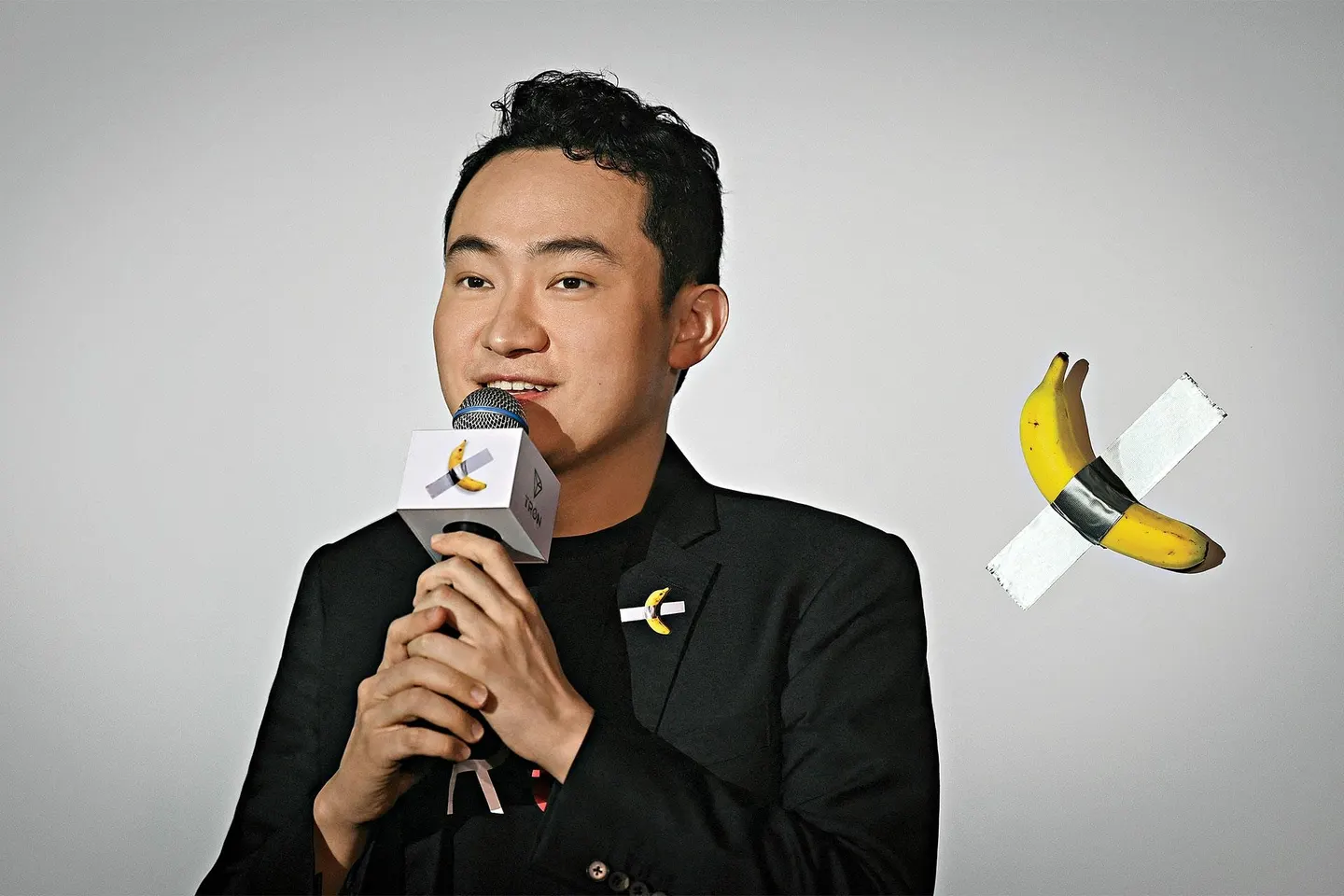Justin Sun, the 34-year-old founder of Tron, landed the daily cover of Forbes after dumping over $80 million into Donald Trump’s crypto startup, World Liberty Financial, helping the U.S. president and his family pocket around $400 million.
The cash came in during a chaotic stretch—Trump had just returned to the White House, and Sun was facing an SEC lawsuit over fraud and securities violations. The Trump project had been spiraling.
The company’s pitch deck, called the “Gold Paper,” featured Trump painted gold and posed like a comic book hero. It offered no real product, no liquidity, no equity, and no legit leadership. Justin still wired $30 million in November 2024, only three weeks after Trump won the election.
“I see WLF as a strong player in the financial technology space,” he said at the time. He then called Trump a “cheat code for crypto” and threw in $45 million more, with 75% of that going straight to Trump, per company terms.
Sun injects millions while SEC backs off
The entire WLF token structure meant that any money over $30 million raised would mostly go to the Trump family. That’s exactly what happened. Then Trump launched $TRUMP, his meme coin, in January 2025. Justin put even more cash in.
He didn’t profit much—he couldn’t even access the funds—but the Trump family walked away with hundreds of millions. Senator Chris Murphy said on the Senate floor in March, “This is essentially Trump posting his Venmo for anyone to secretly wire him as much money as they want.”

Justin got something in return. The SEC dropped lawsuits against crypto companies like Coinbase and Kraken right after Trump returned to power. The agency also paused its case against Justin. He had been accused of wash trading and pushing unregistered tokens through celebrities like Jake Paul and Lindsay Lohan. Those charges are still live, but they’re now frozen.
Justin was immediately named an advisor to World Liberty Financial. His early interest in Trump came from watching The Apprentice reruns in middle school in Huizhou, a city in southern China. His teacher told the class to learn English from TV, and Justin used BitTorrent to download Trump episodes—years before he owned BitTorrent himself.
He said he admired Trump’s showmanship, competition mindset, and oversized ego. “It was natural for The Apprentice to become popular in China,” Justin said. He saw Trump’s branding style as an asset. And when Trump’s crypto company started falling apart, he jumped in.
Tron copies Ethereum, outgrows it in payments
Justin has always moved fast. He created Tron in 2017, claiming it was faster and cheaper than Ethereum. He bought Poloniex and HTX exchanges after watching what Binance and FTX did. He created SunSwap after watching Uniswap grow. By copying other projects and using low fees, he grew Tron’s user base to 300 million.
Binance founder Changpeng Zhao helped push Tron. In 2017, Binance managed Tron’s $70 million ICO just before China banned ICOs. In 2018, Binance added Tron to its Gold Label Project, which made it the default for USDT stablecoin transfers. That drove a massive increase in usage.
By the end of 2019, Tron had over $1 billion worth of Tether moving across it, jumping from $100 million in just a few months. Binance helped by offering 16% interest on Tether held on Tron and removing withdrawal fees. Even when Binance paid over $4 billion in penalties to the U.S. in 2023, and CZ did a prison stint in 2024, Tron was already too deep in the system to slow down.
Chris Maurice, CEO of Yellow Card, said, “Any time I refer to stablecoins, you can just assume that about 70% of it is USDT on Tron.” Yellow Card operates in 20 African countries. Tron’s low fees made it perfect for people sending small amounts, especially in emerging markets. In 2024, Tron’s transaction volume hit $500 billion monthly.
Illicit crypto transactions flood Tron
But with volume came dirty money. TRM Labs reported that 58% of illicit crypto activity in 2024 happened on Tron. That includes over $10 billion in illegal flows, more than both Bitcoin and Ethereum combined. Inca Digital reported that Hezbollah and Hamas used Tron to move at least $2 billion.
Justin said he’s trying to fix that. In September, Tron, Tether, and TRM Labs formed the T3 Financial Crime Unit, which claims to have frozen $130 million in bad funds. Still, U.S. firms aren’t buying it. Circle cut ties with Tron. In December 2024, Coinbase delisted wrapped Bitcoin (wBTC), saying in court, “Mr. Sun’s affiliation with—and potential control over—wBTC presented an unacceptable risk to its customers and the integrity of its exchange.”
Justin’s companies, Tron and BitTorrent, were accused by the SEC of fabricating trading volume to pump the price of TRX. The agency said employees created multiple accounts to fake demand. Sun also allegedly paid celebrities to shill the tokens without disclosing payments.
He didn’t comment on the SEC case. But by giving Trump a financial lifeline right after the election, he may have bought himself breathing room. While he hasn’t met Trump himself, Justin has spent time with Donald Trump Jr. and Eric Trump, who run World Liberty alongside Steve Witkoff’s son.
Justin is banking on Trump’s reach to boost crypto’s reputation. “$TRUMP really breaks the boundaries between Web3 and the traditional world,” he said. He also claimed that after $TRUMP launched, his exchange HTX gained 1 million users in one week—mostly from China, where crypto is banned. He added, “The Chinese government doesn’t want to be seen as banning Trump. I think they are afraid of somebody telling Trump that the Chinese government is banning your coin.”
Forbes values Sun at $8.5 billion, but warns it could be much higher
Justin told Forbes his net worth is over $40 billion, including crypto, art, and an Airbus 330 jet. He said he owns a Warhol, a Picasso, and big stacks of bitcoin and ether. But Forbes estimates the number at $8.5 billion, since many of his assets are unverifiable or stored in other people’s names. Even so, with the SEC stepping off, his real number might climb.
He was born in 1990 in Qinghai, near Tibet, and moved to Guangdong at age 4. His mother was a sports journalist, and his father reported on politics. He was into literature, won a national writing contest in 2007, and entered Peking University to become a writer. He later switched to global history. “Because of this, I see the world as a unified place,” Justin said.
In 2011, he went to the University of Pennsylvania, where Trump also studied, and got a master’s in political economy. In 2012, after reading about Bitcoin, he got obsessed, joined online forums, and ended up as Ripple’s chief rep in China by 2013. But even there, he rubbed people the wrong way. A former Ripple colleague said, “He always said he had connections to the Chinese Communist Party and the government, but to be honest, I don’t think any of those connections were helpful at all… He is money-hungry.”
Justin left Ripple in 2015 and launched Tron in 2017. Ethereum cofounder Vitalik Buterin accused Tron of stealing text from Ethereum’s white paper. Juan Benet, founder of Filecoin, said nine pages were lifted from his own docs. Vitalik once tweeted, “Control+C + Control+V much higher efficiency than keyboard typing new content.” Justin didn’t deny the similarities and said, “Ethereum compatibility was very important.”
Sun eats bananas, buys meme coins, and plans for AI
Justin has a long record of making weird headlines. In 2019, he paid $4.6 million to win a lunch with Warren Buffett, then canceled last minute. He later did the lunch a year later. In 2021, he paid $28 million to ride Jeff Bezos’ Blue Origin spaceship, then missed the launch over “scheduling.” In November 2024, he paid $6.2 million for Maurizio Cattelan’s “The Comedian,” a banana duct-taped to a wall—and then ate it in front of reporters in Hong Kong ten days later.

He calls himself “His Excellency,” a title from his appointment as WTO ambassador for Grenada. He also claims to be prime minister of Liberland, a self-declared microstate on the Danube River. On citizenship, he told Forbes, “I think we can put St. Kitts, probably.”
When asked why he pulls these stunts, Justin said, “Most people probably think I do these things because I want to get everybody’s attention. But actually, when I do things in crypto that come to reality, that is when I get most of it.”
Behind the show, his businesses are growing. His DeFi platform SunSwap, built on Tron, saw over $4 billion in wrapped token trades in December 2024 alone. His meme coin generator SunPump, a copy of Solana’s meme factory, has launched 97,000 tokens since August. They’ve made $37 million so far, compared to Solana’s $600 million in 2024. Justin says Asia will drive the next meme wave. “I think meme coins are capitalizing the internet itself,” he said.
He’s now thinking about how crypto can power AI systems. He said that when AIs hire each other, traditional payments can’t keep up. “That’s gonna take probably six months to do it in the first place,” he said. “But on a highly scalable network, everything can be done in five minutes or five seconds.”
As for what happens next, Justin made it clear: “I want to be a builder of the future world. But first, we have to imagine what the future world will be.”
 cryptopolitan.com
cryptopolitan.com
